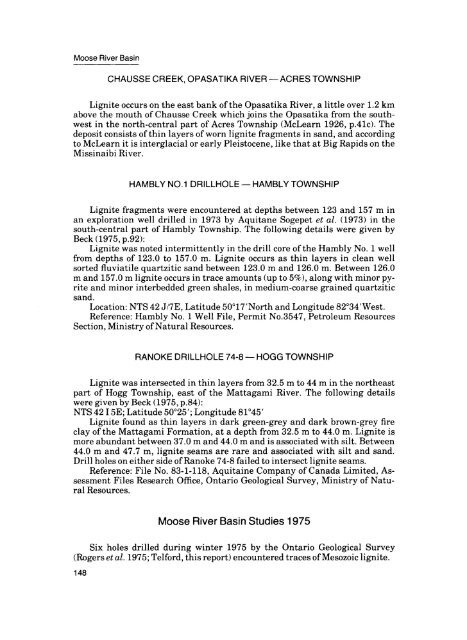Moose River Basin: geology and mineral potential - Geology Ontario
Moose River Basin: geology and mineral potential - Geology Ontario
Moose River Basin: geology and mineral potential - Geology Ontario
Create successful ePaper yourself
Turn your PDF publications into a flip-book with our unique Google optimized e-Paper software.
<strong>Moose</strong> <strong>River</strong> <strong>Basin</strong><br />
CHAUSSE CREEK, OPASATIKA RIVER — ACRES TOWNSHIP<br />
Lignite occurs on the east bank of the Opasatika <strong>River</strong>, a little over 1.2 km<br />
above the mouth of Chausse Creek which joins the Opasatika from the southwest<br />
in the north-central part of Acres Township (McLearn 1926, p.41c). The<br />
deposit consists of thin layers of worn lignite fragments in s<strong>and</strong>, <strong>and</strong> according<br />
to McLearn it is interglacial or early Pleistocene, like that at Big Rapids on the<br />
Missinaibi <strong>River</strong>.<br />
HAMBLY NO.1 DRILLHOLE — HAMBLY TOWNSHIP<br />
Lignite fragments were encountered at depths between 123 <strong>and</strong> 157 m in<br />
an exploration well drilled in 1973 by Aquitane Sogepet et al. (1973) in the<br />
south-central part of Hambly Township. The following details were given by<br />
Beck (1975, p.92):<br />
Lignite was noted intermittently in the drill core of the Hambly No. l well<br />
from depths of 123.0 to 157.0 m. Lignite occurs as thin layers in clean well<br />
sorted fluviatile quartzitic s<strong>and</strong> between 123.0 m <strong>and</strong> 126.0 m. Between 126.0<br />
m <strong>and</strong> 157.0 m lignite occurs in trace amounts (up to 5^c), along with minor py<br />
rite <strong>and</strong> minor interbedded green shales, in medium-coarse grained quartzitic<br />
s<strong>and</strong>.<br />
Location: NTS 42 J/7E, Latitude 50 017'North <strong>and</strong> Longitude 82 034'West.<br />
Reference: Hambly No. l Well File, Permit No.3547, Petroleum Resources<br />
Section, Ministry of Natural Resources.<br />
RANOKE DRILLHOLE 74-8 — HOGG TOWNSHIP<br />
Lignite was intersected in thin layers from 32.5 m to 44 m in the northeast<br />
part of Hogg Township, east of the Mattagami <strong>River</strong>. The following details<br />
were given by Beck (1975, p.84):<br />
NTS 42 15E; Latitude 50 025'; Longitude 81 045'<br />
Lignite found as thin layers in dark green-grey <strong>and</strong> dark brown-grey fire<br />
clay of the Mattagami Formation, at a depth from 32.5 m to 44.0 m. Lignite is<br />
more abundant between 37.0 m <strong>and</strong> 44.0 m <strong>and</strong> is associated with silt. Between<br />
44.0 m <strong>and</strong> 47.7 m, lignite seams are rare <strong>and</strong> associated with silt <strong>and</strong> s<strong>and</strong>.<br />
Drill holes on either side of Ranoke 74-8 failed to intersect lignite seams.<br />
Reference: File No. 83-1-118, Aquitaine Company of Canada Limited, As<br />
sessment Files Research Office, <strong>Ontario</strong> Geological Survey, Ministry of Natu<br />
ral Resources.<br />
<strong>Moose</strong> <strong>River</strong> <strong>Basin</strong> Studies 1975<br />
Six holes drilled during winter 1975 by the <strong>Ontario</strong> Geological Survey<br />
(Rogers et al. 1975; Telford, this report) encountered traces of Mesozoic lignite.<br />
148

















